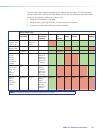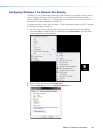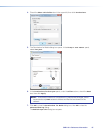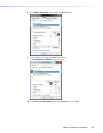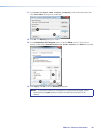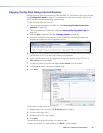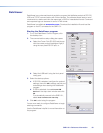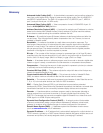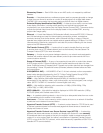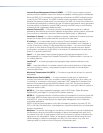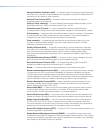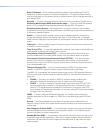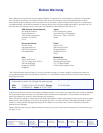
Internet Group Management Protocol (IGMP) — A TCP/IP communications protocol
used by hosts and adjacent routers on a network to establish multicast group memberships.
When the SMD101 is connected to a streaming media server, the IGMP multicast protocol
is used to pull RTSP streams. The IGMP multicast protocol conserves network bandwidth
because the streaming media server only connects to the SMD101 when the connection to
the streaming media server is made by the user. All network switches and routing equipment
must be properly configured to support IGMP snooping and IGMP query to avoid flooding
all endpoints with unnecessary streaming traffic.
Internet Protocol (IP) — The primary protocol that establishes the Internet. It defines
addressing methods and structures for datagram encapsulation, allowing delivery of packets
from a source to a destination across an internetwork based purely on addressing.
Intraframe (I-frame) — In video compression schemes, intraframes (I-frames) are primary
frames that contain the full spatial resolution and data of a video frame.
IP address — A numerical label using the Internet Protocol assigned to devices in a
network. The IP address for the source and destination are included in an IP datagram. A
unique, 32-bit binary number (12-digit dotted decimal notation — xxx.xxx.xxx.xxx) based
on version 4 of the Internet Protocol (IPv4) that identifies each sender and each receiver
of information connected to a LAN, WAN, or the Internet. IP addresses can be static (see
Static IP) or dynamic (see DHCP).
Java™ — A class-based, object oriented programming language developed at Sun
Microsystems®, Inc. (merged with Oracle® Corporation). Programs written in Java can run
on multiple platforms.
JavaScript
®
— A scripting programming language adding interactive features to web
pages.
LAN — Local Area Network. A computer network that connects devices in a limited area,
such as a building or campus, using network equipment that does not include leased
communications lines.
Maximum Transmission Unit (MTU) — The maximum packet size allowed in a network
data packet.
Media Access Control (MAC) — A unique hardware number given to devices that
connect to the Internet. When your computer or networking device (such as a router, hub,
or interface) is connected to the Internet, a table (see "ARP") relates the IP address of the
device to its corresponding physical (MAC) address on the LAN. This protocol allows for
several terminals or network nodes to communicate within a multi-point network, typically a
local area network (LAN).
MPEG-2 — The video compression algorithm used for DVD-Video, Digital Broadcast
Satellite (DBS), and Digital TV (including HDTV) delivery systems.
MPEG-4 — A patented collection of methods defining compression of audio and visual (AV)
digital data. MPEG-4 allows higher amounts of data compression and encoding efficiency
than MPEG-2. It also includes support for digital rights management and for interactive
multimedia applications.
MPEG-4 uses include compression of AV data for streaming media on the web; CD, HD
DVD, or Blu-Ray Disc distribution; voice (telephone, videophone) distribution; and broadcast
television applications.
Multicast — A network technology for the delivery of information to a group of destinations
simultaneously using the most efficient strategy to deliver the messages over each link of
the network only once. A single stream is sent from the source to a group of devices at the
same time in one transmission. Delivery is managed by network switches using the most
efficient strategy to deliver the messages over each link of the network only once, and
creating copies only when the links to the group of destinations split.
SMD101 • Reference Information 96



